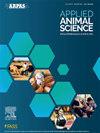Dam and calf behavior in an early separation system under commercial dairy settings
IF 1.5
Q3 AGRICULTURE, DAIRY & ANIMAL SCIENCE
引用次数: 0
Abstract
Objective
This study aimed to describe dam and calf behaviors following calving in an early separation system (≤2 h of life) under commercial dairy settings. Analyzing the association of the early interactions between the dam and her calf with the separation behaviors at the time of calf removal was a secondary objective of this study. Potential associations of reference variables such as parity number, calf sex, calving time, environmental conditions, and time from calving to dam-calf separation with dam- calf interactions and separation behaviors were also tested.
Materials and Methods
A total of 163 calvings were video recorded for analysis. Associations among the 3 groups of variables (reference; dam-calf interactions; and separation behavior) were initially tested using the chi- squared test of independence. Subsequently, significant associations of reference and dam-calf interaction variables with separation behaviors identified in the chi-squared test of independence were analyzed by multivariate logistic regression.
Results and Discussion
According to the chi-squared test, the only separation behavior affected by reference variables was calf seeking the dam, which occurred more often in morning calvings, calvings in the dry lot, and when there was greater time from calving to separation. On the contrary, associations between the occurrence of dam-calf interactions and the expression of separation behaviors were identified for most of the variables, with calf attempting suckling showing the most evident associations. The subsequent multivariate logistic regression analysis identified that calf seeking their dam at separation was positively associated with calving in the dry lot (reference variable) and calf suckling their dams (dam-calf interaction variable). In addition, both dam following her calf and dam watching her calf at separation were positively associated with calf attempting suckling (dam-calf interaction variable).
Implications and Applications
The cows and calves in this study evidenced some immediate reactions to separation occurring before 2 h after calving. Further research into the long-term effects of early separation between the dam and calf in commercial settings would offer a broader perspective on the relevance of the findings reported in this study.
商业奶场环境下早期分离系统中的母犊行为
目的本研究旨在描述在商业奶牛场设置的早期分离系统(≤2小时生命)中产犊后母牛和小牛的行为。本研究的第二个目的是分析水坝与小牛之间的早期相互作用与小牛移除时的分离行为之间的关系。参考变量如胎次数、小牛性别、产犊时间、环境条件以及从产犊到坝-小牛分离的时间与坝-小牛相互作用和分离行为的潜在关联也进行了测试。材料与方法对163块石刻进行录像分析。三组变量(参考、坝-小牛相互作用和分离行为)之间的关联最初使用独立性的卡方检验进行检验。随后,通过卡方独立性检验,对参考变量和坝-小牛相互作用变量与分离行为的显著相关性进行多因素logistic回归分析。结果与讨论卡方检验显示,受参考变量影响的分离行为仅为小牛找坝,在早晨产犊、干地产犊、产犊至分离时间较长时更为常见。相反,在大多数变量中,发现了坝-小牛相互作用的发生与分离行为的表达之间的关联,小牛试图哺乳表现出最明显的关联。随后的多变量logistic回归分析发现,小牛在分离时寻找他们的水坝与在干地产犊(参考变量)和小牛吮吸他们的水坝(水坝-小牛相互作用变量)呈正相关。此外,母鹿跟随母鹿和母鹿在分离时看着母鹿都与母鹿试图哺乳呈正相关(母鹿-母鹿相互作用变量)。意义和应用本研究中的奶牛和小牛在产犊后2小时内对分离有一些直接反应。对商业环境中过早分离大坝和小牛的长期影响的进一步研究,将为本研究报告的结果的相关性提供更广泛的视角。
本文章由计算机程序翻译,如有差异,请以英文原文为准。
求助全文
约1分钟内获得全文
求助全文

 求助内容:
求助内容: 应助结果提醒方式:
应助结果提醒方式:


